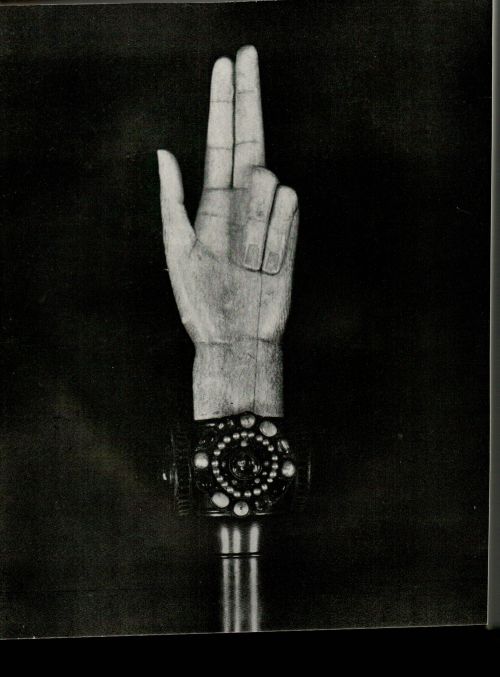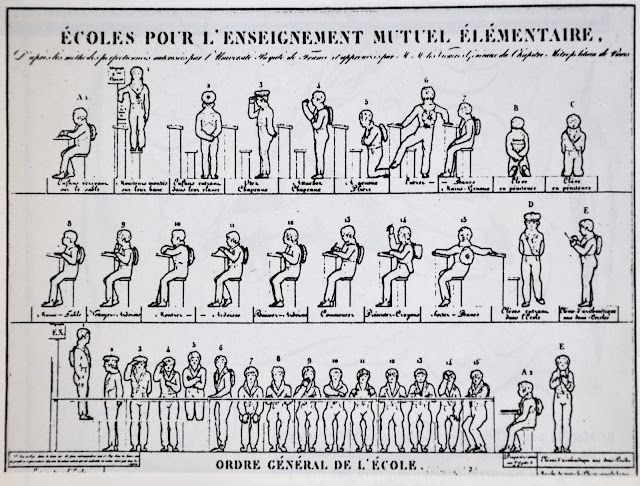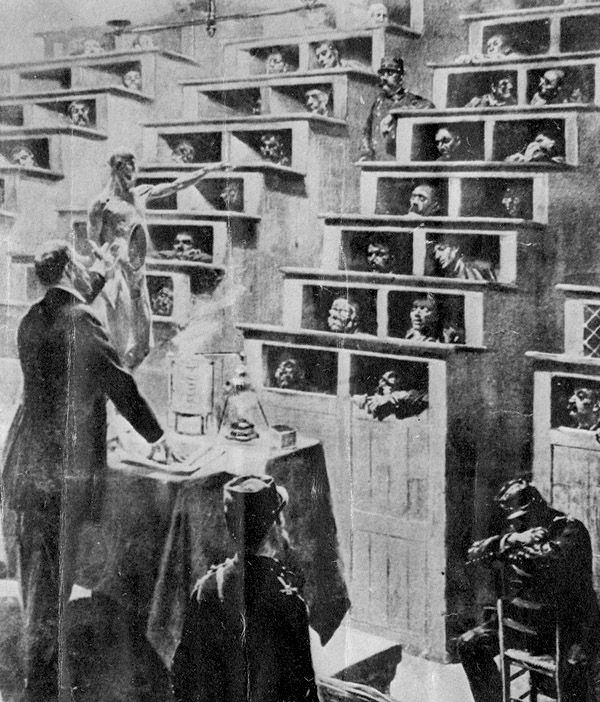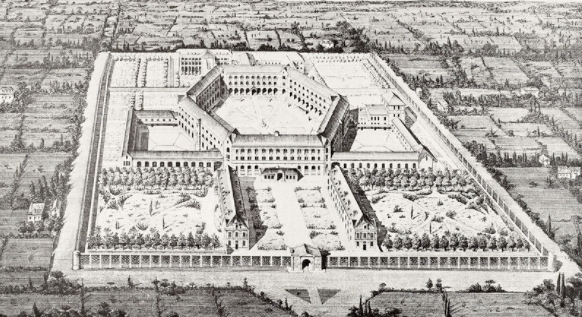Changes in the way power is run - education, labor, prisons
generalized punishment
Beginning in the second half of the 18th century, theorists and politicians began to no longer hold their existing views on "torture". As a concept that has been re-valued, "human" has become an important impetus for torture reform. "Human" has been reconsidered as a disrespected subject, but at this time, for torture or human beings as a free subject, the mitigation of torture has become a manifestation of negative freedom, showing a kind of "I don't want..." rather than "I want to..." claim.
The softening of punishment stems from the "softening" of the crime itself. In the second half of the eighteenth century and even the nineteenth century, crime gradually separated from the form of deprivation of life or violent crime. This phenomenon reflects the improvement of living standards and the gradual construction of people's attention to property. The aggravation of punishment and the completeness of the police system also affect the crime itself. On the one hand, crimes are more "soft" and on the other hand, they tend to be hidden, but the number of crimes has not decreased.
In addition, the messiness of the judicial system itself is also one of the factors that lead to the moderation of the punishment system. For example, there were different judicial institutions such as feudal lord justice, royal justice, etc., which were affected by the collision of different interests (the positions of judges could be obtained through buying and selling), resulting in uneven effectiveness and punishment standards.
What reformers are trying to change is not the power base and the extent to which it can be controlled, but rather the way that power is managed. For example, the scope of jurisdiction under the previous judicial system was inconsistent, and the scope of deep power was relatively inefficient and small. Therefore, in their view, the traditional power management method is too mixed and messy, and a more efficient and precise power management method is needed. As Foucault puts it:
Let the punishment and suppression of illegal behavior be the only function that has rules and covers the whole society; not to punish less, but to punish better; the severity of punishment may be reduced because of this, but it will make punishment more universal and inevitable higher; and embed the power of punishment deeper into the social body. (page 144)

Forms of crime before the eighteenth century often revolved around so-called rights-based crimes (such as tax evasion). Fix loopholes in the law. With the development of the economy, people's emphasis on property gradually redefines various criminal behaviors. Rights-based crimes have gradually evolved into property-based crimes , and classes also tend to take different forms of crime according to their own interests. Rights-based crimes are used by the bourgeoisie in tax evasion, etc., while the lower classes achieve property-based crimes in the form of violence. crime.
The law enforcement of the upper power and the crime of the lower common people jointly promote the reform of the criminal law. The superior power manifests its power through a single "king", which has no limits and no norms; while the inferior commoners are constantly engaged in illegal acts, whose characteristics are flat, comprehensive and universal. Torture before the reform was where these two forces overlapped. With capitalism’s emphasis on property, people’s criminal behavior became more common, flat, and frequent, and the two gradually became out of balance and promoted the reform of criminal law. The features of the reform are:
The new criminal legislation is characterized by a softening of penalties, a clearer codification, a marked reduction in arbitrariness, a better consensus on the power to punish , underpinned by dramatic changes in the traditional way of doing business that is illegal, and A set of strict limits to keep the alignment of their hearts going. (page 155)
The criminal is seen as a self-contradictory identity. On the one hand, citizens are regarded as subject to all laws. On the other hand, the punishment for the offender is also the "law" imposed by the society. part. Therefore, universal punishment faces the problem of the severity of punishment. Criminals and society form an unequal field of confrontation in law. The former is rejected by the latter as a conflict and threat to the continuation of the whole. What can be seen from this is that an absolutely unequal punishment may be imposed on a single criminal, so the power of punishment itself must be limited.
So why was torture before the eighteenth century able to demonstrate unlimited punitive powers? Because the purpose of punishment is different from before, from the ruler's "retaliation" against the perpetrator to a social (interest damage) prevention mechanism . The power displayed here cannot be intimidated by absolute force as before, nor can it be performed in the form of "torture". Punishments that represent "justice" cannot be related to or feel similar to criminal acts. Accordingly, the concept of "human nature" was invoked and replaced the word "power regulation". In addition, the concept of "preventing the future" has also been incorporated into the reform of the criminal law. The cruelty of the perpetrator in torture is only aimed at erasing the crimes committed by him in the past; while the reform of the criminal law is to prevent similar cases in the future . crime to disrupt the order. Therefore, punishment no longer emphasizes the process of punishment and the display of power, but emphasizes the self-calibration between the criminal and the society .
On the basis of torture, the reform principles of punishment are as follows:
- Minimum amount rule : Make the cost of punishment slightly higher than the benefit of crime.
- Sufficient Conceptual Rule : The "concept" of pain displayed in the punishment can be displayed, and there is no need or emphasis on physical "real" torture.
- Peripheral effect rule : The person who achieves the imaginary punishment gets the greatest deterrent effect, while the person who is actually punished does not necessarily get the same real punishment effect.
- Completely clear rules : Clearly defined what is criminal and legal, and available to anyone.
- Common rule of truth : The judiciary itself does not "break the law", the government itself and the criminals will abide by the norms of the law, and there will be no double standards.
- Best Clarification Rule : All violations will be classified, neither excessive nor missing.
The above six principles demonstrate the softening of punishment and regulate criminal activity in a relatively "scientific" way. Secondly, it can also be seen that compared with the previous torture, the punishment gradually changed the strict control over the body of the perpetrator, and then turned to the control of the crime or the "spirit" of the general society. Punishment:
It is no longer the body, with its associated ritual role of excessive torture, the imprint that shines in the ritual of torture; it is now the spirit, or rather the role of a set of representations and symbols, circulating in a low-key and unremarkable way, but in There is inevitability and certainty in the spirit of all people. (page 174)
Reason, humanity, science replaced torture, and spirit replaced body...

softness of punishment
The reform of punishment was gradually established on a set of "representation" art, which reproduced the power display that had happened in torture, but the punishment at this time was more efficient, more comprehensive and more common. Through "representation", Power comes in through different images. Reproduction follows the following principles:
- What constitutes crime is governed by the interests of society as a whole, no longer defined by authoritarian means. Measuring what constitutes a crime in terms of the overall interest fixes crime and punishment in the very nature of things, the act of crime itself. Arbitrary power is concealed in this form, making people believe in the inevitability of the law. (criminal act itself is a crime)
- Reduce the temptation for people to commit crimes and increase the cost of being punished for committing crimes. Let the criminals bear the crimes they have committed by themselves, and let the criminals who infringe on other people's property punish them with their own labor, which not only brings more benefits to the society, but also allows the criminals to make up for the social benefits by themselves. In other words, punishment is reproduced in the crime in the way of "prescribe the right medicine".
- The penalty is fixed-term imprisonment. Limitations of punishment are necessary in order for offenders to improve their crimes.
- Punishment not only acts on the offender, but also on the "potential criminal". Allowing criminals to repair the harm they have caused to social interests, for example, allowing criminals to repair public facilities, on the one hand, allows criminals to make up for their faults, and on the other hand, allows the punishment to be "realized", which means that criminals can be seen in a visible form for every crime. Personal service, when people use public facilities, can easily associate with the symbols of crime and punishment.
- In the past, torture was used as punishment to warn people not to commit crimes in a way of "killing chickens to warn monkeys"; now, moral laws are presented in various announcements, performances, paintings, art, etc., and moral laws and laws are closely linked. In other words, people What is directly seen is the law, not the power itself. Both the law and the criminal act can be directly imagined, and when the criminal act occurs, it is possible to know what kind of punishment will come. Therefore, all warnings are so direct and perfect.
- If all of the above principles are realized, then the "Liao Tianding"-style praise of criminal heroes will be completely reversed. People's imagination of criminals will be transformed into an individual who can be educated in morality. Through the improvement of social system, this individual will be more moral and more orderly. In this process, morality has become a very important link, and all kinds of people (poets, writers, etc.) will use the way of moral preaching to pass on ten, spread ten by one, and comprehensively rewrite the essence of crime.
The essence of power has not changed, but the business model has become more effective and comprehensive, even if she is soft:
"Therefore, he will be exposed and endure all the rigors of the season, sometimes with snow and ice covering his forehead, sometimes with the scorching sun. And it is in this violent torture that it is rather a kind of It is the prolongation of painful death, not the prolongation of life of suffering—in which one can truly compare a scum who has committed the most horrific and is sentenced to no longer see the heaven he has disobeyed, and no longer dwell in the land he has defiled." Over the city of punishment sits this iron spider; and it is the kinslayer who should be so crucified by the new law. (p. 203; citing Vermeer, On the Reform of Our Criminal Legislation, 1781, pp. 148-149)
The above six principles reflect the imagination of criminal law reformers for gradually softening, transparent and open punishment. But why did " incarceration" become the most mainstream punishment category in the future? Incarceration represents the darkest and most undisclosed form of punishment, and it serves as vigilance against "potential perpetrators", and it is also an expensive punishment that is not the most beneficial to the interests of society as a whole. So why did he become the most common form of punishment? Foucault then cites some examples for discussion:
The earliest large-scale prison can be traced back to the "file house" in Amsterdam. It can be said that it is a kind of punishment mixed with torture theory and punishment prison technology in the second half of the eighteenth century. It is achieved through personal education and spiritual transformation. purpose of punishment.
The Compulsory Court in the Ghent District of Belgium organized criminals to work, and combined the concepts of laziness and labor and imposed them on criminals. The sentence was justified in the name of correction, and at the same time, it was possible to obtain financial subsidies from criminals.
England added the concept of "isolation" to the above. Prisons are seen as a space for negative and bad role models. On the contrary, people in prisons are also able to reflect on themselves and reflect on the evil in their hearts because of their "isolation". Here, the prison is constructed as an intermediary or transit point between the orderly state and the evil place,
The Philadelphia model of the United States further deepens the prison principles of the above models. Rigorous work and rest, and meaningful labor all show that the prison is playing the role of returning the lost citizens to the orderly capitalist world. In addition, Philadelphia's Walnut Street Prison also has its own characteristics:
- The punishment is not public, the public only needs to know why they are punished, and the content of the punishment is only a matter between the prisoner and the monitor. The public can deter crime simply by knowing that prisoners will be punished.
- Distinguish the strengths and weaknesses of different prisoners through regular observation (Walnut Street Jail divides four categories of prisoners: those who have committed serious wrongs in prison, repeat offenders or morally depraved, non-reciprocal offenders, and unknown attributes. ), and develop a set of individual knowledge systems that are relevant to individuals.


Through the above examples, we can find out the similarities and differences between prisons and penal reformers. What is certain is that both take precautions as the core of their construction, and hold a preventive mentality against "potential crimes". But in punishment (reformer), the role of the criminal is a sign of reappearance, which re-directs the display of overall power to the criminal's body and redirects it into the two concepts of crime and punishment, in other words, it reinforces this connection again. Corrective punishment (prison) works in a completely different way, domesticating an obedient subject through intense control of the criminal's body (punishment is a subject that domesticates a law because it needs to be in line with social interests.) Therefore, The two forms of punishment are completely different methods. Punishment is the judicial subject to rebuild social conventions , while prison uses coercive power to shape obedient individuals who bow to power.
One side involves the operation of a penal power, which is distributed throughout the social space; everywhere, whether in scenes, performances, signs, or discourses; it is readable, like an open book; Operates in an intermittent recodification manner; ensuring deterrence of crime by placing these barriers into the concept of crime. ...the other side involves a dense operation of the power of punishment: through a system of authority and knowledge, a delicate control of the body and time of the prisoner, a restraint on his posture and behavior; a supporting plastic surgery Applied to prisoners in order to rectify them individually; an autonomous administration of powers from outside the body of society and above all the judiciary. (page 230)
("Surveillance and Punishment: The Birth of the Prison" Reading Summary #2)
References
Michel Foucault, Surveillance and Punishment: The Birth of the Prison, Taipei: Times Culture, 2020.
Wu Micha, Sovereignty and Justice: A French Experience , 2016.
Ruthless business:
In the construction of the Bar Learning Community, welcome to create a friendly and decentralized learning community together! Join us to supervise each other and learn from each other!
In the recent book club, we will read the book "Gender Ties: Demolition of Patriarchal Illegal Buildings" . Those who haven't read the book are fine. Friends, welcome to join our DC group to discuss!
Like my work? Don't forget to support and clap, let me know that you are with me on the road of creation. Keep this enthusiasm together!


- Author
- More